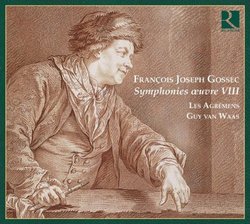The Surprising Music of Francois-Joseph Gossec
M. C. Passarella | Lawrenceville, GA | 12/02/2008
(5 out of 5 stars)
"The influence of two very different musical figures hovers over the two very different types of musical offerings on this CD, part of a series dedicated to the music of the Parisian Concert spirituel. First, there is Johann Stamitz, a pioneer of the symphony. His debut in Paris in 1754 at the Concert spirituel undoubtedly inspired Gossec's symphonic production; between 1756 and 1765, when the three symphonies of Opus 8 were published, Gossec produced 20 symphonies. Like many of Stamitz's symphonies, they follow the four-movement model (which Stamitz pioneered) and feature the clarinet, a novelty in French symphonies of the period. Like Stamitz's symphonies, Gossec's employ independent writing for the winds, which add surprising splashes of color to the orchestral palette.
These three symphonies are bright, good-natured works that are also sturdily constructed and orchestrated. Of course in time, Gossec's symphonies would be superseded by those of Haydn, Mozart, and his compatriot Mehul, but clearly Gossec was on the cutting edge of symphonic writing in the 1760s.
The other influence is Rameau, who helped establish Gossec when he came to Paris from Antwerp in 1751. Sabinus (1771), a tragedie-lyrique, comes from the period of Gossec's life when he turned increasingly to the stage, an area where he failed to find the sort of success he enjoyed as a purely instrumental composer. But the suite drawn from the opera shows that Gossec was every bit as imaginative in following Rameau's lead as he was in following Stamitz's. The music of Sabinus is sprightly and colorful, with a Tambourin featuring a tambourine as well as the eponymous little drum, along with imitations of the piffero. The final Chaconne includes a Spanish dance episode complete with a pair of castanets.
This is all very surprising music, played with verve and obvious relish by Les Agremens. The recording, made in the hall of the Liege Philharmonic, is almost aggressively close in perspective, but this just adds to the dash of the performance. The notes to the recording praise the hall's acoustics. Indeed, instrumental timbre is very true, and the ear adjusts easily to what is in effect a front-row seat.
Interestingly, I first came to admire Gossec through a third and very different musical genre, that of liturgical choral music. Gossec's Requiem of 1760 influenced both Mozart and Berlioz, and it still impresses. The more I hear of M. Gossec, the more I want to hear.
"


 Track Listings (18) - Disc #1
Track Listings (18) - Disc #1